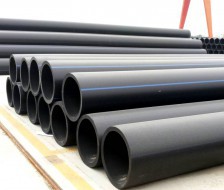

Although water pipelines are also installed on the ground nowadays, most of them still need to be installed underground for use. Therefore, after installing PE pipes, we also need to conduct pressure tests to prevent them from experiencing unbearable water pressure during use, which could lead to their rupture.
Why can't gas pressure test be used instead of water pressure after PE pipe installation? The reference index for PE pipe welding work can be obtained: welding temperature: 220 degrees ± 10 degrees, therefore. Heating time: 9-12 seconds for pipe wall thickness *. Gas has the following properties that are beneficial for pressure testing of PE pipes: 1. Due to the instability of the gas medium. Moreover, it is prone to compression and stretching, and the volume of gas varies with the size of the space: after entering the PE pipeline, the gas will fill the entire space. When the ambient temperature rises, expansion occurs, and the volume is greatly affected by temperature: the volume of gas is greatly affected by temperature. Easy to cause instantaneous pressure rise and explosion in the pipeline. Moreover, it is difficult to detect leaks in pipelines. Difficult to identify pipeline leaks: the gas is colorless and odorless.
If the physical properties of the water medium are more stable compared to the gas medium, then the pressure exerted on the inner wall of the pipe is more uniform. Therefore, considering the stability of the physical properties of the water medium, it is more intuitive to detect whether there are leaks. The inspection effect of the pressure bearing capacity of the pipe is more accurate.
And everyone should also pay attention to the temperature of PE pipes, which may vary with the seasons throughout the year. It will also have an impact on the construction equipment of PE pipelines. Taking the common ambient temperature of 20 ℃ as an example, the normal welding temperature for PE pipes should be 220 degrees Celsius, and the heating time should be the pipe wall thickness * 10 seconds. But according to different temperatures, corresponding adjustments can be made. The following suggestions are suggested.

1.The heating time is the wall thickness of the pipe multiplied by 12 seconds.When the temperature is below 10℃,the welding temperature can be set to 230 degrees.
2.The heating time is the wall thickness of the pipe multiplied by 11 seconds.The welding temperature can be set to 225 degrees Celsius between 20℃and 10℃.
3.The heating time is the wall thickness of the pipe multiplied by 10 seconds.The welding temperature can be set to 220 degrees Celsius at 310℃-20℃.
4.The heating time is the wall thickness of the pipe multiplied by 10 seconds.The welding temperature can be set to 210 degrees Celsius at 420℃-30℃.
5.The heating time is the wall thickness of the pipe x 9 seconds.When the temperature is above 530℃,the welding temperature can be set to 205 degrees.
If the water pressure test is normal after the installation of the PE pipe,construction can continue.If there are problems,solving them will save some trouble.In addition to pressure related usage issues,effective control is also needed when facing temperature changes to ensure normal use.